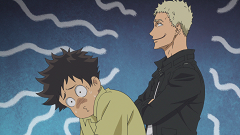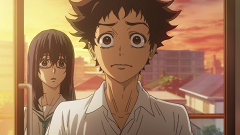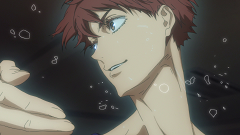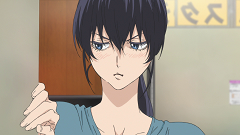After a strong start to its two cour season, Ballroom e Youkoso has managed to waltz its way past all potential stumbling blocks and deliver an even better second episode. There was a lot to love here, including a carefully introduced rival and love triangle, great voicework from Shinba Tsuchiya, and some promising animation during a late solo dance sequence. Ballroom isn’t above including anime tropes like the always-classy ‘interrupted changing scene,’ and lead character Fujita’s latent genius is a bit too evident after just two installments, but the team at Production I.G. is doing a lot more things right than wrong. Let’s break them down step by step.
The episode is named after Kiyoharu Hyodo, the biggest of the three characters it introduces (the other two being Banba and Jinbo, Fujita’s friendly but underqualified dance instructors). Sengoku describes Hyodo as a “monster” who stands in complete dominance of Japan’s amateur DanceSport scene. He’s full of intensity on the floor, but totally aloof when he’s away from it, demonstrating his nonchalance throughout the episode via several cavernous yawns. Even if you think these are intentional, Hyodo is quite agreeable for a rival character in anime, especially given his young age and outrageous skill. He demonstrates a basic waltz step for his new studio-mate with only a slight protest, and keeps his cool when Fujita later interrupts his solo practice. The hitch is that Hyodo is involved in a nine-year dance partnership with Shizuku, on whom our hero has a massive crush.
When Sengoku teases that Fujita might try to steal his partner, Hyodo claims not to care. Shizuku, however, appears to care very much, blushing and pouting at his level-headed response. Thus the love triangle falls into place, with the only question mark being where Hyodo’s affections lie. Attractive and talented as Shizuku is, it’s hard to imagine that he wouldn’t be interested, but he doesn’t seem to be; even when presented with the opportunity to train overseas with her, he’s content to stay in Japan. This is clearly discouraging to Shizuku, who thinks Hyodo is “on another level” and considers herself “lucky he’s my partner.” The hero worship here made me a little wary of potential Sakura Syndrome, where a major female character acts only as a bystander or cheerleader, but the groundwork has been laid for Shizuku to undergo her own arc. Natsu from Baby Steps is a good model for how I hope her character is handled over the course of the series – always improving and competing against rivals of her own, even as she functions as a love interest for two different guys.
On the production side of things, the stills and CG dancers returned for another episode, but all was forgiven during one of the final scenes this week. During a solo practice session of Hyodo’s, the art became more sketch-like and the animation more fluid, giving a powerful, dynamic feel to his movements. Even if it only lasted for a few seconds, this willingness to break model and use a rougher style to capture a different energy is a confidence booster. I especially liked this choice given that Fujita was observing him, and needed to be inspired by what he saw to push the story forward. Speaking of Fujita, Shinba Tsuchiya is a breath of fresh air as his voice actor, imbuing the character with a nice blend of self-consciousness and enthusiasm. Tsuchiya is a newcomer to the seiyuu world, but he’s already drawing comparisons to Daiki Yamashita, who voices Deku on Boku no Hero Academia, so his future looks bright. Hopefully Ballroom’s future remains just as promising as the show starts covering multiple manga chapters per episode.





Hyodo’s dancing was so intense! Seeing his passion for dance (and for Shizuku?) I’m already more interested in this guy and his story than in the MC.
I really like the distinct style of the art, the expressions and dance movements, the ones that move, seem so detailed. Haikyuu is really captivating with similar art and I really appreciate how much more personalised it looks and less……mass produced.
The art is certainly distinct, but ironically, the manga character designs have been modified to fit the Haikyuu mold. If Ballroom is as big a hit as its predecessor, we could be looking at a new model for mass production.
I agree that Hyodo is more interesting than Fujita, especially since his reasons for working so hard are still unclear. Wonder how he’ll react when the new kid on the block starts becoming a real threat at competitions?
That’s quite interesting, about the character designs. Not having seen any of the manga I didn’t realise. It gives characters so much more personality though so I’m excited for something more than sameface with different coloured hair.
Hyodo’s definitely not lacking motivation, maybe it’s inspiration he needs? And this is shounen so really grand signature moves and peformances are in order! (Please, I’m so keen to see it in this setting!)